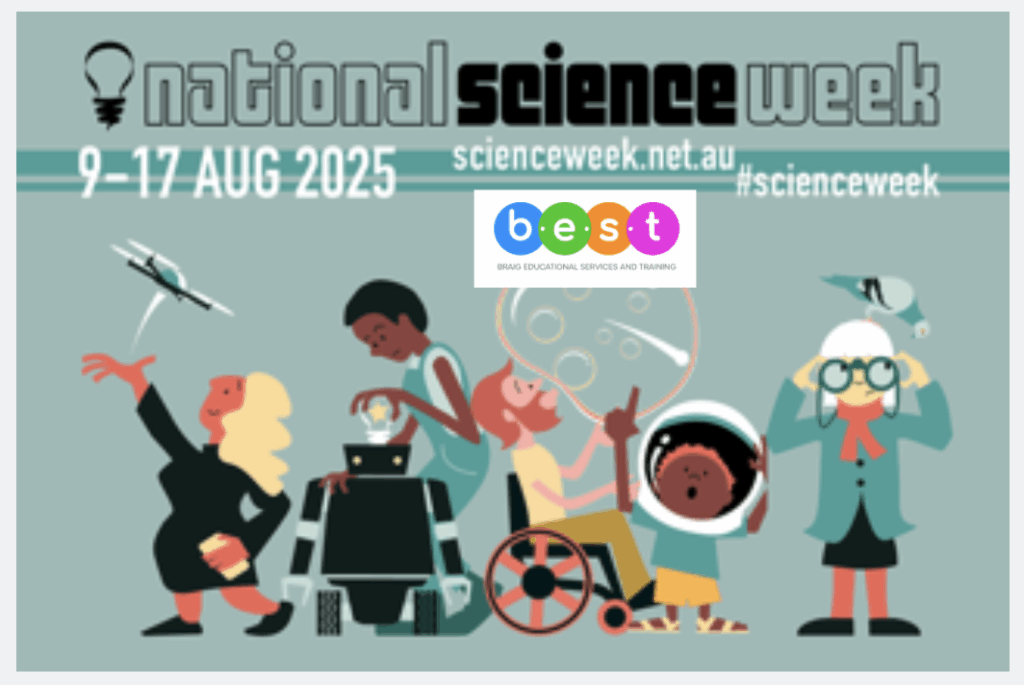Perfect for National Science Week in Australia 10 – 18 August 2025
Science Week 2025 (10–18 August) invites children and educators alike to explore the wonders of the universe — from patterns in nature to invisible forces — through curiosity, observation, and experimentation. By embedding science learning into everyday experiences—especially during Science Week—your service can demonstrate a strong commitment to holistic learning exceed the expectations of the National Quality Standard (NQS).
The theme for National Science Week in 2025 is Decoding the Universe – Exploring the unknown with nature’s hidden language. This theme invites children and teachers across Australia to delve into the mysteries of the Universe by exploring the fundamental languages of nature, including mathematics and the groundbreaking field of quantum science.
On the science week website there are many resources packed with information, classroom activities, experiments, diagrams, photographs, and website links
The 2025 teacher resource book exploring the theme Decoding the Universe – Exploring the unknown with nature’s hidden language is now live! Download the resource book and student journal here.
Quality Area 1 – Educational Program and Practice
Standard 1.2 – Practice
Educators facilitate and extend each child’s learning through intentional teaching.
Embedded Practice
- Use nature walks to explore patterns in leaves, shells, or spider webs — documenting what children notice about symmetry, textures, or sequences.
- Set up provocations like shadow play, sound experiments, or floating materials — allowing children to decode and test their theories.
Critical Reflection
- Reflect on how children’s inquiries connect to deeper concepts: gravity, light, magnetism, patterns, or cause and effect.
- Document educators’ reflections on children’s scientific thinking and how it informs future planning.
Meaningful Engagement
- Incorporate children’s questions (“Why does the moon change shape?” or “What makes things float?”) into your learning program.
- Use these inquiries as launching pads for further investigation — showing responsiveness and intentional teaching.
Quality Area 6 – Collaborative Partnerships with Families and Community
Standard 6.2 – Community Engagement
Embedded Practice
- Invite parents to share knowledge related to the theme (e.g., astronomy, gardening, coding, nature play).
- Display children’s discoveries and theories publicly to invite conversation and community participation.
Critical Reflection
- Evaluate how effectively your service connects science to children’s cultural backgrounds, family interests, and home environments.
Meaningful Engagement
- Send home “Science in a Jar” kits (e.g., cloud in a jar, light refraction) and ask families to share back results, photos, or questions.
- Host a Family Science Night where children lead the exploration using materials they’ve investigated during the week.
Helpful Resources and Links
- National Science week 2025: https://www.scienceweek.net.au/schools/
– Fizzics education: https://www.fizzicseducation.com.au/articles/national-science-week-2025-for-preschoolers/
- Early STEM Australia: https://earlychildhoodstem.org.au/
– Questacon Early Learning: https://www.questacon.edu.au/
– National Science Week: https://www.scienceweek.net.au/
– Little Scientists Australia: https://littlescientists.org.au/
– Raising Children Network: https://raisingchildren.net.au/guides/activity-guides/science
– STEMIE Toolkit: https://stemie.fpg.unc.edu/
– Preschool Science Activities (Little Bins): https://littlebinsforlittlehands.com/preschool-science-activities/
Ideas for your science based early childhood educational program
Ideas particularly for early childhood education include nature walks with crayon rubbings, simple pattern matching games, and introducing basic concepts of shape and symmetry found in nature. These activities can be linked to the theme by discussing how nature uses patterns and codes to communicate or organise itself.
1. Nature’s Patterns and Textures:
- Nature Walk and Rubbings:
Take children on a nature walk to collect leaves, bark, and other natural items. Have them create crayon rubbings of these items to reveal their unique textures and patterns.
- Pattern Matching:
Introduce simple pattern matching games using natural objects like rocks, leaves, or seeds. Children can sort items by shape, size, or colour, or create patterns with them.
2. Simple Codes and Signals:
- Animal Sounds:
Listen to recordings of different animal sounds and discuss how animals use sounds to communicate. Children can try to imitate the sounds or create their own animal sound signals.
- Symbolic Representation:
Introduce simple symbols or pictograms and have children create their own picture messages. This can be linked to the idea of how scientists use symbols to represent scientific concepts.
3. Connecting to the Theme:
- Nature’s Architecture:
Discuss how plants and animals create structures using patterns and shapes (e.g., honeycomb, spiderwebs). Encourage children to build their own structures using blocks or other materials, mimicking nature’s designs.
- Celestial Bodies:
Introduce basic concepts about the sun, moon, and stars, linking them to patterns in the sky. Simple activities like making suncatchers or exploring the shapes of stars can be used.
Let BEST Childcare Consulting Help You Shine
At BEST Childcare Consulting, we empower early learning services to turn curiosity into evidence of exceeding practice. Science Week is a perfect time to highlight how your service supports confident, involved learners while engaging families and communities.
Ask us how today.
